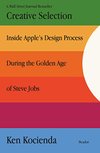Creative Selection: Inside Apple's Design Process During the Golden Age of Steve Jobs
amazon.com
Creative Selection: Inside Apple's Design Process During the Golden Age of Steve Jobs

Demos served as the primary means to turn ideas into software. The setup of these demo review meetings reveals how we went about making our software great.
thought back to the Black Slab Encounter with Safari. That breakthrough didn’t represent an end; it signaled a beginning. As exciting as it was to see our web browser render the first sliver of a web page, we realized what the milestone meant.
Whiteboard discussions feel like work, but often they’re not, since it’s too difficult to talk productively about ideas in the abstract. Think of a cute puppy. The Purple team rarely worked without concrete and specific artifacts, and the story of the keyboard derby illustrates how.
In any complex effort, communicating a well-articulated vision for what you’re trying to do is the starting point for figuring out how to do it. And though coming up with such a vision is difficult, it’s unquestionably more difficult to complete the entire circuit, to come up with an idea, a plan to realize the idea, and then actualize the plan at
... See moreMy goal is to share our approach with you—to explain the way we worked. To begin this discussion, I have identified seven elements essential to Apple’s software success: Inspiration: Thinking big ideas and imagining what might be possible Collaboration: Working together well with other people and seeking to combine your complementary strengths
... See moreGreg had an encyclopedic knowledge of the history of computing, a tinkerer’s knowledge of analog and digital hardware, and a gut feeling for how to create software that made sense to people. A couple years earlier, Greg had given me crucial advice during the development of the iPhone keyboard. At a point when I was desperately stuck, he challenged
... See morehe had none of the emotional connection I had to my keyboard. While I had been working hard on it, for Phil it was brand new, and he was indifferent to it. He expected the software to win him over, and apparently, it didn’t.
Apple didn’t invent direct manipulation—a computer scientist named Ben Shneiderman
He reasoned these alone would be sufficiently compelling proofs of concept.